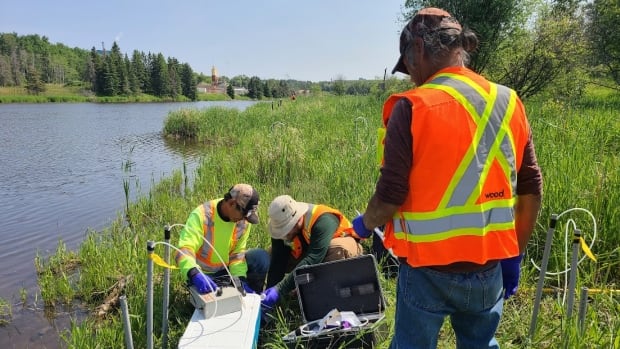A new study from the University of Western Ontario suggests mercury contamination in northwestern Ontario’s English-Wabigoon River has been made worse by ongoing industrial pollution.
Contamination of the river system dates back to the 1960s and 70s, when the pulp and paper mill dumped an estimated nine tonnes of mercury into the water.
The mercury has impacted generations of people living in Grassy Narrows First Nation, also known as Asubpeeschoseewagong Netum Anishinabek, and Wabaseemoong Independent Nation, a community about 150 kilometres from Dryden near the Ontario-Manitoba border.
However, the new study, published Thursday, has found that discharge of wastewater from the Dryden Paper Mill, combined with existing mercury, has created high levels of methylmercury – an even more toxic compound.
“Other forms of mercury don’t accumulate as strongly as methylmercury, but because it accumulates, it builds up to high levels in organisms, presenting that greater risk,” said Brian Branfireun, a biology professor at the University of Western Ontario. “It’s actually more serious than I even imagined.”

The experiment was conducted by masters student Eric Grimm under Branfireun’s supervision.
Dianne Loewen, communications and engagement co-ordinator for Dryden Fibre Canada, the owner of the Dryden Paper Mill, said in an email to CBC News on Wednesday that she could not comment on the study.
“Dryden Fibre Canada only recently acquired the mill from Domtar. We are not in a position to comment as we have not seen, nor have we been briefed on, Dr. Branfireun’s report.”
Dryden Fibre Canada took over the mill from Domtar in August 2023.
Poison through the food chain
While the wastewater coming from the mill today does not contain mercury, it does contain high levels of sulfate and organic matter, which “feed the bacteria that produce methylmercury from inorganic mercury in the environment,” the study says.
These toxins build up in the river’s fish, which are then passed on to the people that consume them.
“The accumulation of methylmercury in the human body causes neuromuscular problems and can also lead to death,” Branfireun said.

Just under 1,000 people live in Grassy Narrows First Nation, which is about 90 kilometres north of Kenora, Ont., and fish are a staple part of the community’s diet.
“Most of the families continue to fish, they continue to eat the fish. It’s something they’ve done for hundreds of years – you can’t really stop them,” said Grassy Narrows Chief Rudy Turtle in an interview with CBC News.
It is estimated that 90 per cent of Grassy Narrows’ population has symptoms of mercury poisoning, which causes problems including tremors, insomnia, memory loss, neuromuscular effects, headaches and cognitive and motor dysfunction.
For years, Turtle has called for the paper mill to be closed and for the river to be cleaned up. The community has also been anxiously awaiting the construction of a Mercury Care Home, for which the federal government signed a funding agreement in 2020.
“We continue to be poisoned,” said Turtle, who himself has shared his experiences with mercury poisoning.
Mercury Care Home construction slated for summer
Anispiragas Piragasanathar, a spokesperson for Indigenous Services Canada (ISC), provided CBC News an emailed statement about the Mercury Care Home.
Piragasanathar said the federal government has committed:
- $77M to build the Mercury Care Home.
- $68.9M for operations, maintenance and specialized service delivery.
“ISC continues to support Grassy Narrows leadership as they take steps toward realizing their vision for health-care delivery in their community through the Mercury Care Home,” Piragasanathar said.
“Together, we have developed key construction milestones to ensure that the Mercury Care Home is built in a timely manner.”
Construction is planned to begin by July 1 and take about two to three years to complete.
Turtle said he is pleased with the additional funds the government has committed to the project this year, and that a ceremony will be held in the community once the shovels hit the ground.
No simple solutions
It is possible to remove the methylmercury from the water – but it won’t be easy, Branfireun said
“We are talking about potentially hundreds of kilometres of rivers and lakes and wetlands in a very complicated landscape that is not developed,” he said.
While cleaning up the river will take substantial time and resources, removing the sulfate and organic matter is a more manageable solution for the short-term, Branfireun said.
“It wouldn’t completely solve the mercury problem in fish in this river, but it would dramatically improve it while these other remediation strategies are being implemented over the next few decades.”
Michael Rennie is an associate professor at Lakehead University’s biology department, as well as a research fellow at the International Institute for Sustainable Development (IISD) Experimental Lakes Area.
While he was not involved in the methylmercury study, he said he is not surprised by the results.
We are talking about potentially hundreds of kilometres of rivers and lakes and wetlands in a very complicated landscape that is not developed.– Brian Branfireun, University of Western Ontario
“It shows a pretty clear role for the impact that the mill has on the system now just from the effluent that’s going into it from the current operations,” Rennie said in an interview with CBC News.
There are ways to reduce the impact of mill operations on the river, Rennie said, such as settling ponds or new environmental policies, but the level of contamination throughout the system means there are no simple solutions.
“I don’t think this is saying, ‘Oh my God, we have to close the mill.’
“What I think it’s saying is there are likely industrial processes that can be put in to help reduce sulfate concentrations that are coming out of that effluent to help reduce organic matter, that will at least not make the problem continue to be worse,” he said.
Branfireun is expected to share the study’s findings on Thursday morning at the Earth Sciences Centre in Toronto.






